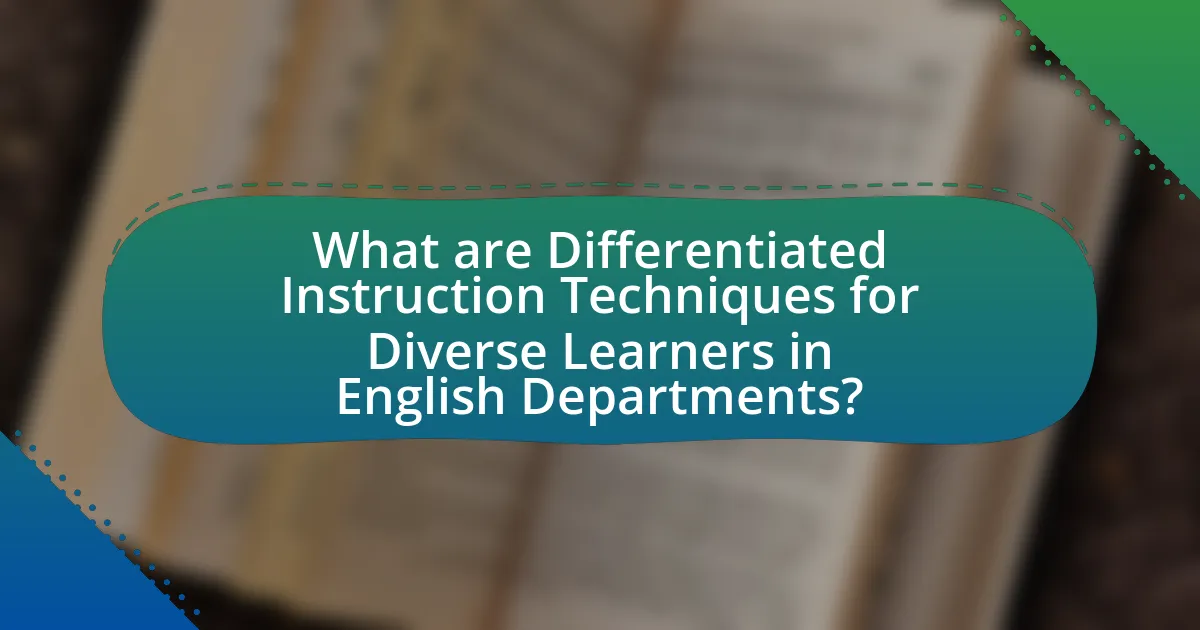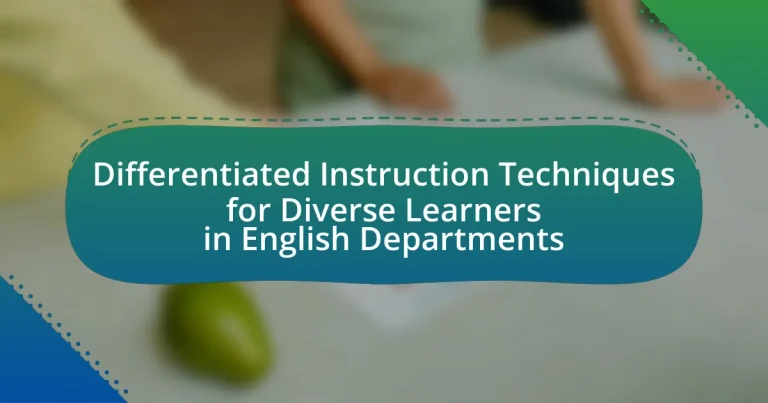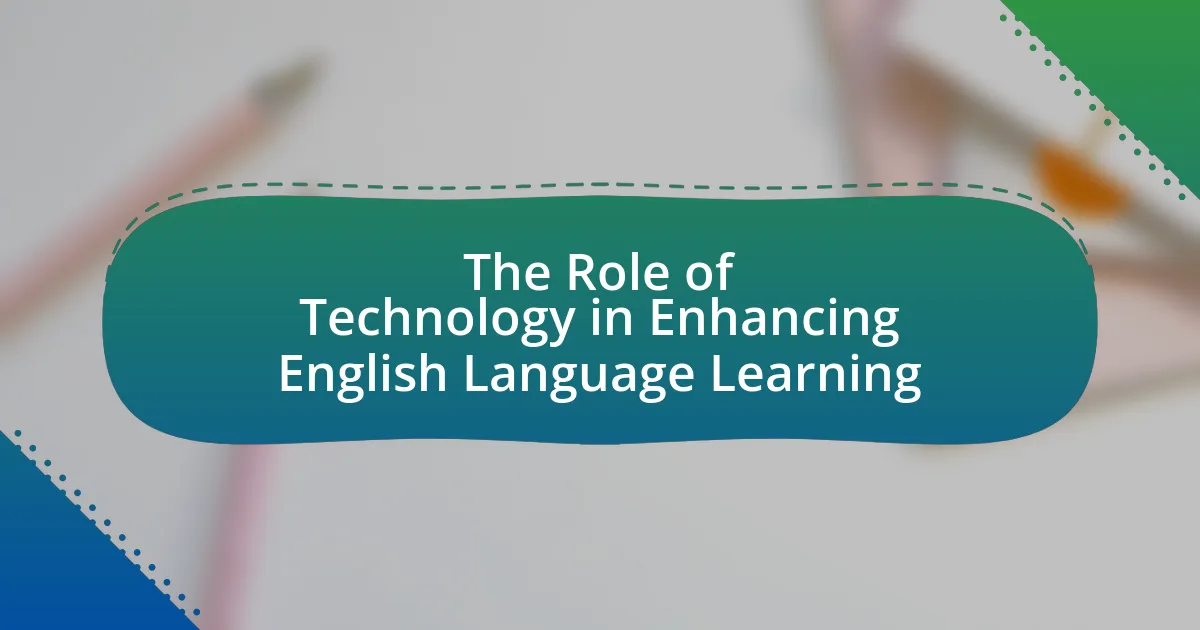Differentiated instruction techniques for diverse learners in English departments focus on strategies such as flexible grouping, varied instructional methods, and tailored assessments to meet individual student needs. These techniques address challenges faced by diverse learners, including language barriers and varying literacy levels, by personalizing educational experiences to enhance engagement and academic performance. Research supports the effectiveness of differentiated instruction in improving student outcomes, highlighting the importance of adapting teaching methods to accommodate different learning styles and preferences. Key principles guiding these techniques include recognizing students’ unique backgrounds and readiness levels, which inform the development of instructional strategies and assessment practices.

What are Differentiated Instruction Techniques for Diverse Learners in English Departments?
Differentiated instruction techniques for diverse learners in English departments include flexible grouping, varied instructional strategies, and tailored assessments. Flexible grouping allows educators to form dynamic groups based on students’ needs, interests, or learning profiles, facilitating peer collaboration and targeted instruction. Varied instructional strategies, such as using multimedia resources, hands-on activities, and differentiated reading materials, cater to different learning styles and abilities, enhancing engagement and comprehension. Tailored assessments, including formative assessments and choice boards, enable teachers to evaluate student understanding in diverse ways, ensuring that all learners can demonstrate their knowledge effectively. These techniques are supported by research indicating that differentiated instruction improves student outcomes by addressing individual learning needs.
How do these techniques address the needs of diverse learners?
Differentiated instruction techniques effectively address the needs of diverse learners by tailoring educational experiences to individual learning preferences, readiness levels, and interests. These techniques, such as flexible grouping, varied instructional strategies, and personalized assessments, ensure that all students engage with the material in a way that resonates with them. Research indicates that when teachers implement differentiated instruction, student engagement increases, leading to improved academic outcomes. For instance, a study by Tomlinson (2001) highlights that differentiated instruction can significantly enhance student motivation and achievement, particularly in heterogeneous classrooms.
What specific challenges do diverse learners face in English departments?
Diverse learners in English departments face challenges such as language barriers, varying levels of literacy, and differing cultural backgrounds. Language barriers hinder comprehension and communication, making it difficult for learners to engage fully with course material. Varying literacy levels can lead to disparities in understanding texts and completing assignments, which may affect academic performance. Additionally, differing cultural backgrounds can result in misunderstandings or a lack of relevance in course content, impacting students’ ability to connect with the material. These challenges necessitate tailored instructional strategies to support diverse learners effectively.
How can differentiated instruction techniques mitigate these challenges?
Differentiated instruction techniques can mitigate challenges faced by diverse learners in English departments by tailoring teaching methods to meet individual student needs. These techniques, such as flexible grouping, varied instructional strategies, and personalized assessments, allow educators to address different learning styles and paces. Research indicates that when teachers implement differentiated instruction, student engagement and achievement improve, as evidenced by a study published in the “Journal of Educational Psychology,” which found that differentiated practices led to a 20% increase in student performance in diverse classrooms. By adapting content, process, and product based on student readiness, interests, and learning profiles, differentiated instruction effectively supports all learners, reducing barriers to success.
Why is differentiated instruction important in English departments?
Differentiated instruction is important in English departments because it addresses the diverse learning needs of students, enhancing their engagement and academic success. English classes often include students with varying levels of reading comprehension, writing skills, and language proficiency. By employing differentiated instruction strategies, educators can tailor their teaching methods, materials, and assessments to meet these individual needs, thereby fostering a more inclusive learning environment. Research indicates that differentiated instruction can lead to improved student outcomes, as it allows for personalized learning experiences that cater to each student’s strengths and weaknesses. For instance, a study by Tomlinson (2001) highlights that when teachers differentiate instruction, students are more likely to achieve higher levels of understanding and retention of material.
What impact does differentiated instruction have on student engagement?
Differentiated instruction significantly enhances student engagement by tailoring learning experiences to meet diverse needs and preferences. This approach allows educators to provide varied instructional strategies, materials, and assessments, which cater to individual learning styles and interests. Research indicates that when students feel their unique needs are addressed, their motivation and participation in classroom activities increase. For instance, a study by Tomlinson (2001) found that differentiated instruction leads to higher levels of student engagement and achievement, as it fosters a more inclusive and responsive learning environment.
How does it influence academic performance among diverse learners?
Differentiated instruction significantly influences academic performance among diverse learners by tailoring teaching methods to meet individual needs. This approach enhances engagement and understanding, as it accommodates various learning styles, backgrounds, and abilities. Research indicates that when educators implement differentiated strategies, such as flexible grouping and varied instructional materials, students demonstrate improved academic outcomes. For instance, a study by Tomlinson (2001) in “How to Differentiate Instruction in Mixed-Ability Classrooms” shows that students in differentiated environments often achieve higher test scores and exhibit greater motivation compared to those in traditional, one-size-fits-all classrooms.
What are the key principles of differentiated instruction?
The key principles of differentiated instruction include recognizing students’ varying backgrounds, readiness levels, interests, and learning profiles to tailor teaching methods accordingly. This approach emphasizes flexible grouping, ongoing assessment, and adjusting content, process, and product based on individual student needs. Research by Tomlinson (2001) highlights that effective differentiation leads to increased student engagement and achievement by addressing diverse learning preferences and abilities.
How do these principles guide the development of instructional strategies?
Principles of differentiated instruction guide the development of instructional strategies by emphasizing the need to tailor teaching methods to accommodate diverse learners’ varying readiness levels, interests, and learning profiles. These principles advocate for flexible grouping, ongoing assessment, and varied instructional approaches, ensuring that all students engage with the material in a way that meets their individual needs. Research by Tomlinson (2001) highlights that applying these principles leads to increased student engagement and improved academic outcomes, as instruction becomes more relevant and accessible to each learner.
What role does assessment play in differentiated instruction?
Assessment plays a critical role in differentiated instruction by providing educators with the necessary data to tailor their teaching strategies to meet the diverse needs of learners. Through formative and summative assessments, teachers can identify students’ strengths, weaknesses, and learning preferences, enabling them to adjust their instructional methods accordingly. Research indicates that differentiated instruction, supported by ongoing assessment, leads to improved student engagement and achievement, as it allows for personalized learning experiences that cater to individual differences. For instance, a study by Tomlinson (2001) highlights that effective assessment practices are essential for informing instructional decisions and fostering an inclusive classroom environment.
How can teachers implement differentiated instruction techniques effectively?
Teachers can implement differentiated instruction techniques effectively by assessing students’ individual learning needs and tailoring their instructional strategies accordingly. This involves using various methods such as flexible grouping, tiered assignments, and learning centers to accommodate different skill levels and learning styles. Research indicates that differentiated instruction can lead to improved student engagement and achievement, as evidenced by a study conducted by Tomlinson (2001) which found that students in differentiated classrooms showed higher levels of motivation and academic success compared to those in traditional settings. By continuously monitoring student progress and adjusting instruction based on feedback, teachers can create a more inclusive and effective learning environment.
What strategies can be used to assess student readiness and interests?
To assess student readiness and interests, educators can implement strategies such as pre-assessments, interest inventories, and formative assessments. Pre-assessments, which include quizzes or diagnostic tests, help identify students’ existing knowledge and skills, allowing teachers to tailor instruction accordingly. Interest inventories, such as surveys or questionnaires, gather information about students’ preferences and passions, guiding curriculum choices that engage learners. Formative assessments, including observations and class discussions, provide ongoing insights into student understanding and engagement levels, enabling timely adjustments to teaching methods. These strategies collectively ensure that instruction is aligned with students’ readiness and interests, fostering a more effective learning environment.
How can teachers create flexible learning environments?
Teachers can create flexible learning environments by incorporating varied instructional strategies, utilizing technology, and designing adaptable classroom layouts. Varied instructional strategies, such as differentiated instruction, allow teachers to tailor lessons to meet diverse learning needs, enhancing engagement and comprehension. The integration of technology, like online resources and interactive tools, provides students with personalized learning experiences that cater to their individual pace and style. Additionally, adaptable classroom layouts, which include movable furniture and designated areas for collaboration, enable students to choose their learning space, fostering autonomy and comfort. Research indicates that flexible learning environments can improve student outcomes by accommodating different learning preferences and promoting active participation.
What specific differentiated instruction techniques can be applied in English departments?
Specific differentiated instruction techniques that can be applied in English departments include flexible grouping, tiered assignments, and learning centers. Flexible grouping allows teachers to organize students based on their skill levels or interests, facilitating targeted instruction. Tiered assignments enable educators to create tasks at varying levels of difficulty, ensuring that all students are challenged appropriately. Learning centers provide diverse activities that cater to different learning styles, allowing students to engage with content in ways that suit them best. These techniques are supported by research indicating that differentiated instruction enhances student engagement and achievement in diverse classrooms.
How can tiered assignments enhance learning for diverse learners?
Tiered assignments enhance learning for diverse learners by providing varying levels of complexity and support tailored to individual student needs. This approach allows educators to address different readiness levels, interests, and learning profiles within a single classroom. Research indicates that when students engage with material that is appropriately challenging, they demonstrate increased motivation and deeper understanding. For instance, a study by Tomlinson (2001) highlights that tiered assignments can lead to improved academic performance and engagement among students with diverse learning abilities, as they can work at their own pace and level of understanding.
What role does choice in reading materials play in differentiation?
Choice in reading materials plays a crucial role in differentiation by allowing educators to tailor content to meet the diverse interests and reading levels of students. This personalization enhances engagement and motivation, as students are more likely to connect with texts that resonate with their experiences and preferences. Research indicates that when students have the autonomy to select their reading materials, they demonstrate improved comprehension and retention, as evidenced by a study published in the Journal of Educational Psychology, which found that choice significantly boosts student achievement in literacy. Thus, providing options in reading materials is an effective strategy for addressing the varied needs of learners in English departments.
How can technology support differentiated instruction in English departments?
Technology can support differentiated instruction in English departments by providing personalized learning experiences tailored to individual student needs. For instance, adaptive learning software can assess students’ reading levels and adjust the complexity of texts accordingly, ensuring that each learner engages with material that is appropriately challenging. Research indicates that using technology, such as online platforms that offer varied resources and formats, enhances student engagement and comprehension, as evidenced by a study from the International Society for Technology in Education, which found that 78% of teachers reported improved student performance through technology integration. This demonstrates that technology not only facilitates differentiated instruction but also leads to measurable academic benefits.
What tools and resources are available for teachers to use?
Teachers have access to a variety of tools and resources designed to support differentiated instruction for diverse learners in English departments. These include digital platforms like Google Classroom and Edmodo for managing assignments and communication, as well as educational resources such as ReadWorks and Newsela that provide leveled reading materials tailored to different student abilities. Additionally, tools like Kahoot and Quizlet facilitate interactive learning and assessment, allowing teachers to engage students in a way that meets their individual needs. Research indicates that utilizing diverse instructional tools can enhance student engagement and learning outcomes, as evidenced by studies showing improved performance in classrooms that implement differentiated strategies effectively.
How can online platforms facilitate personalized learning experiences?
Online platforms can facilitate personalized learning experiences by utilizing adaptive learning technologies that tailor educational content to individual student needs. These platforms analyze user data, such as learning pace and comprehension levels, to customize lessons and resources, ensuring that each learner receives appropriate challenges and support. For instance, platforms like Khan Academy employ algorithms that adjust the difficulty of exercises based on student performance, which has been shown to improve engagement and mastery of subjects. Additionally, online platforms often provide diverse multimedia resources, allowing learners to choose formats that resonate with their learning styles, further enhancing personalization.
What are some best practices for evaluating the effectiveness of differentiated instruction?
Best practices for evaluating the effectiveness of differentiated instruction include using formative assessments, gathering student feedback, and analyzing student performance data. Formative assessments, such as quizzes and observations, provide immediate insights into student understanding and engagement, allowing educators to adjust instruction accordingly. Gathering student feedback through surveys or discussions helps educators understand the impact of differentiated strategies on learning experiences. Analyzing performance data, including test scores and assignment completion rates, offers concrete evidence of student progress and the effectiveness of instructional methods. Research indicates that these practices lead to improved student outcomes and more tailored instructional approaches, as highlighted in studies by Tomlinson and Strickland (2005) in “Leading and Managing a Differentiated Classroom.”
How can feedback from students inform instructional adjustments?
Feedback from students can inform instructional adjustments by providing insights into their understanding, engagement, and learning preferences. When educators collect and analyze student feedback, they can identify specific areas where students struggle or excel, allowing for targeted modifications in teaching strategies. For instance, a study by Hattie and Timperley (2007) highlights that feedback is crucial for enhancing student learning outcomes, as it helps teachers understand the effectiveness of their instructional methods. By implementing changes based on this feedback, such as adjusting lesson pacing or incorporating varied instructional materials, educators can better meet the diverse needs of learners in English departments.
What metrics should be used to measure student progress in differentiated settings?
To measure student progress in differentiated settings, educators should utilize metrics such as formative assessments, student self-assessments, and individualized learning goals. Formative assessments, including quizzes and class discussions, provide ongoing feedback on student understanding and engagement, allowing for timely adjustments in instruction. Student self-assessments encourage learners to reflect on their own progress and set personal goals, fostering ownership of their learning. Individualized learning goals, tailored to each student’s needs and abilities, help track specific progress over time. Research indicates that these metrics effectively capture diverse learning outcomes, as they align with the principles of differentiated instruction by recognizing individual student growth and achievement.
What practical tips can teachers use to enhance differentiated instruction in their classrooms?
Teachers can enhance differentiated instruction by employing flexible grouping strategies, which allow students to work in varied configurations based on their learning needs and preferences. This approach enables teachers to tailor instruction to diverse learners, fostering collaboration and peer support. Research indicates that flexible grouping can improve student engagement and achievement, as it accommodates different learning styles and paces. For instance, a study by Tomlinson (2001) highlights that when students are grouped according to their readiness, interests, or learning profiles, they demonstrate higher levels of motivation and understanding.




